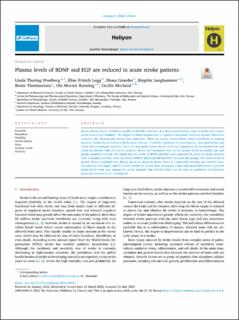| dc.contributor.author | Øverberg, Linda Thøring | |
| dc.contributor.author | Lugg, Elise Fritsch | |
| dc.contributor.author | Gaarder, Mona | |
| dc.contributor.author | Langhammer, Birgitta | |
| dc.contributor.author | Thommessen, Bente | |
| dc.contributor.author | Rønning, Ole Morten | |
| dc.contributor.author | Morland, Cecilie | |
| dc.date.accessioned | 2023-02-14T10:02:10Z | |
| dc.date.available | 2023-02-14T10:02:10Z | |
| dc.date.created | 2022-09-21T09:11:55Z | |
| dc.date.issued | 2022-06-17 | |
| dc.identifier.citation | Heliyon. 2022, 8 (6), 1-10. | en_US |
| dc.identifier.issn | 2405-8440 | |
| dc.identifier.uri | https://hdl.handle.net/11250/3050618 | |
| dc.description.abstract | Stroke affects almost 14 million people worldwide each year. It is the second leading cause of death and a major cause of acquired disability. The degree of initial impairment in cognitive and motor functions greatly affects the recovery, but idiosyncratic factors also contribute. These are largely unidentified, which contributes to making accurate prediction of recovery challenging. Release of soluble regulators of neurotoxicity, neuroprotection and repair are presumably essential. Here we measured plasma levels of known regulators of neuroprotection and repair in patients with mild acute ischemic stroke and compared them to the plasma levels in healthy age and gender matched controls. We found that the levels of BDNF and EGF were substantially lower in stroke patients than in healthy controls, while the levels of bFGF and irisin did not differ between the groups. The lower levels of growth factors highlight that during the acute phase of stroke, there is a mismatch between the need for neuroprotection and repair, and the brain's ability to induce these processes. Large individual differences in growth factor levels were seen among the stroke patients, but whether these can be used as predictors of long-term prognosis remains to be investigated. | en_US |
| dc.language.iso | eng | en_US |
| dc.publisher | Elsevier | en_US |
| dc.relation.ispartofseries | Heliyon;Volume 8, Issue 6, e09661 | |
| dc.rights | Navngivelse 4.0 Internasjonal | * |
| dc.rights.uri | http://creativecommons.org/licenses/by/4.0/deed.no | * |
| dc.subject | Biomarkers | en_US |
| dc.subject | Disabilities | en_US |
| dc.subject | Growth factors | en_US |
| dc.subject | Irisin | en_US |
| dc.subject | Ischemic stroke | en_US |
| dc.subject | Plasticity | en_US |
| dc.title | Plasma levels of BDNF and EGF are reduced in acute stroke patients | en_US |
| dc.type | Peer reviewed | en_US |
| dc.type | Journal article | en_US |
| dc.description.version | publishedVersion | en_US |
| dc.rights.holder | © 2022 The Author(s) | en_US |
| dc.source.articlenumber | e09661 | en_US |
| cristin.ispublished | true | |
| cristin.fulltext | original | |
| cristin.qualitycode | 1 | |
| dc.identifier.doi | https://doi.org/10.1016/j.heliyon.2022.e09661 | |
| dc.identifier.cristin | 2053747 | |
| dc.source.journal | Heliyon | en_US |
| dc.source.volume | 8 | en_US |
| dc.source.issue | 6 | en_US |
| dc.source.pagenumber | 1-10 | en_US |

